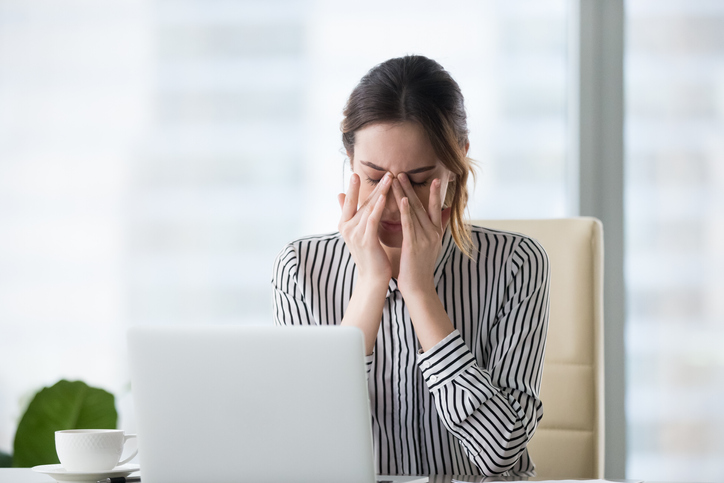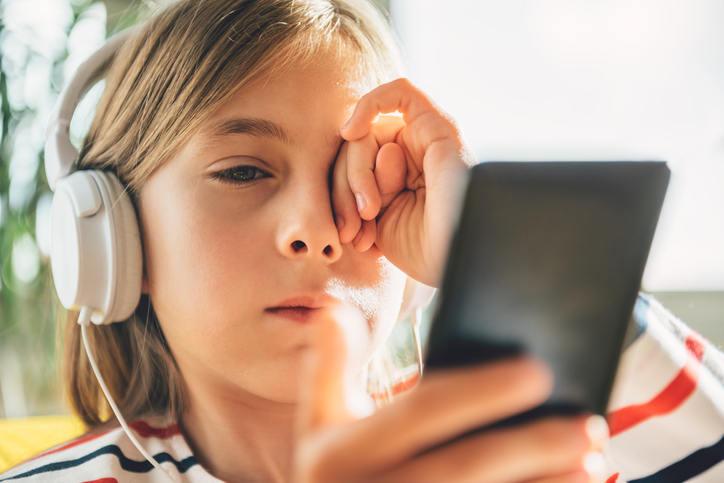Are Your Eyes Bothering You From All Of That Non-Stop Zooming and Streaming? What a Top Optometrist Wants You and Your Family to Know
Whether you’re still working from home or have returned to your place of business, chances are you can answer this question without batting an eye: “Are you or your kids spending more time staring at computers, phones, or televisions since the lockdown?”
The answer is probably a resounding, yes. While a little binge-watching may have quelled some of the anxiety you felt about the pandemic, there’s a fairly good chance that your eyes aren’t fairing so well thanks to all the extra blue light those devices emit. And, if your eyes hurt, think about how your children’s must feel.

Close-Contact Viewing Really Can Damage Your Eyes
Remember being told that if you sat too close to the TV, you’d ruin your eyes? There’s more truth in that statement than most people realize. Unlike traditional media, such as books and magazines, digital images are less precise, which makes them harder to read. Reflections and glare from glass screens contribute to eye strain and fatigue as well. Because of these factors, experts recommend that digital devices be used from a safe viewing distance.
- Mobile phones – 1 foot
- Desktop computers or laptops – 2 feet
- Televisions – 10 feet or more depending on the screen size
Optometrists have also begun diagnosing Digital Eye Strain, also known as Computer Vision Syndrome (CVS). Dr. Neda Gioia is the owner of Integrative Vision. She’s also one of the only U.S. optometrists who has completed the Institute for Functional Medicine’s AFMCP module, which teaches clinicians how to personalize treatment based on a patient’s lifestyle, environment, and individual history. Dr. Gioia says that, “CVS causes headaches, blurred vision, and even neck pain.”

The Device Isn’t The Only Problem
Since Zoom meetings and online education won’t be going away anytime soon, it’s important to fine-tune your online viewing habits as well. That laptop on your kitchen table probably forces you to focus at a different angle than a traditional external monitor would. And, if you’re reclining or working from a bed or sofa, your eyes probably aren’t level with the screen. Both of these factors contribute to eye strain, as does insufficient lighting and poor posture. When working on your computer, make sure your shoulders are level and that your head, neck, and pelvis are aligned vertically. Make sure your desk or table is at least 26” high and that the screen is only slightly below eye level. If the desk is higher than 26 inches, tilt the screen slightly, so that it’s angled away from about 10 to 20 degrees.

Your Child’s Vision Can Suffer Even More Than Yours
As a parent, you want what’s best for your child. Dr. Gioia explained that anatomically, “Children are unable to absorb the same amount of high energy, short-wavelength blue light that adults can.” In layman’s terms, the cornea and crystalline lens behind the iris generally protect the retina from damage, but more blue light passes through a child’s protective lens instead of being absorbed by it. “Also,” she says, “when a child’s focal point is limited, his or her focusing muscle is constantly active, which is not natural or healthy long term, and can induce myopia [also known as nearsightedness].”
Tips and Advice From The Experts
Since the term “social distancing” is now part of our vernacular, consider “distancing” yourself from your device every 30 to 60 minutes to ensure better posture and less eye strain. If you’re an eye-drop addict, ditch the redness-reducing variety, which may make your eyes feel even worse. Dr. Gioia has also created a helpful article full of tips to relieve the pain associated with our newly-expanded digital habits. She covers everything from proper posture while working on the computer to the 20/20/20 rule recommended by the American Academy of Ophthalmology. In short, get in the habit of looking 20 feet away from your primary focal point for 20 seconds every 20 minutes. , warming eye masks, and microwaveable compresses also work wonders.
If your eyes are generally healthy, and you’re not experiencing symptoms of degraded vision, schedule routine eye exams yearly for yourself, and follow your healthcare provider’s recommendations for your children. But if your eyes are excessively dry, don’t work in tandem with one another, or seem unable to focus, it’s time to seek your optometrist’s help. “Dry eye syndrome, convergence insufficiency, and accommodative (focusing) instability” can only be diagnosed by your doctor.
Our Beauty Advisors (aestheticians, facialists, makeup artists, and beauty professionals) recommend the AZN Labs Eye Patches to soothe the areas around your eyes.

Loading...